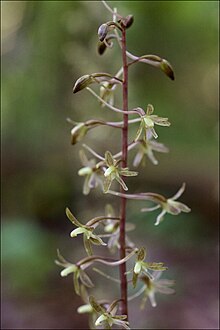Tipularia discolor
| Tipularia discolor | |
|---|---|

| |
| Scientific classification | |
| Kingdom: | Plantae |
| Clade: | Tracheophytes |
| Clade: | Angiosperms |
| Clade: | Monocots |
| Order: | Asparagales |
| Family: | Orchidaceae |
| Subfamily: | Epidendroideae |
| Genus: | Tipularia |
| Species: | T. discolor
|
| Binomial name | |
| Tipularia discolor (Pursh) Nuttall[1]
| |
| Synonyms[2] | |
| |
Tipularia discolor, the crippled cranefly[3] or crane-fly orchid, is a perennial terrestrial woodland orchid, a member of the family Orchidaceae.[1] It is the only species of the genus Tipularia found in North America. It occurs in the southeastern United States from Texas to Florida, the range extending north into the Ohio Valley and along the Appalachians as far north as the Catskills. There are also isolated populations in Massachusetts and in the Great Lakes region.[4][5]
Tipularia discolor grows a single leaf in September that disappears in the spring. The leaf top is green, often with dark purple spots. The leaf underside is a striking purple color. The flower blooms in mid-July to late August. The roots are a connected series of edible corms. They are starchy and almost potato-like.
The plant is pollinated by noctuid moths, by means of flowers which incline slightly to the right or left, so the pollinaria can attach to one of the moth's compound eyes.[6] The details of the inflorescence can be seen in a video recorded in State Botanical Gardens in Athens, GA .[7]
Crane-fly orchids are endangered, threatened, or rare in several states.[3]
-
Clonal group
-
Colony, with seed pods, Florida, February.
-
Purple underside of leaf
-
Flowers
-
Seed pods
-
Broken seed pod with micrograph of seed insert.
References
- ^ a b Justice, William S.; Bell, C. Ritchie; Lindsey, Anne H. (2005). Wild Flowers of North Carolina (2. printing. ed.). Chapel Hill, NC: Univ. of North Carolina Press. p. 156. ISBN 0807855979.
- ^ Kew World Checklist of Selected Plant Families
- ^ a b NRCS. "Tipularia discolor". PLANTS Database. United States Department of Agriculture (USDA). Retrieved 9 December 2015.
- ^ "Tipularia discolor in Flora of North America @ efloras.org". www.efloras.org. Retrieved 2016-03-25.
- ^ Biota of North America Program, county distribution map
- ^ "Tipularia discolor". Flora of North America.
- ^ Sezen, Uzay. "Crippled Cranefly Orchid (Tipularia discolor) (2014)". Retrieved 6 June 2017.
- Homoya, Michael A. (1993). Orchids of Indiana. Indiana University Press. ISBN 0-253-32864-0.
External links
 Media related to Tipularia discolor at Wikimedia Commons
Media related to Tipularia discolor at Wikimedia Commons







